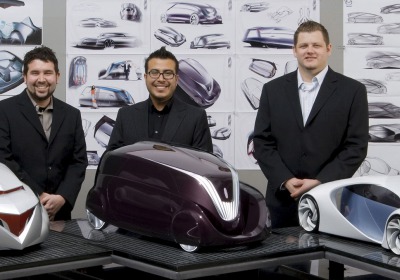CCS-AISI Project 2008
Fri, 10 Oct 2008The College for Creative Studies (CCS) recently celebrated 20 years of partnership with the American Iron and Steel Institute (AISI). Illustrating that environmental responsibility needn't come at the expense of design, power or desire, three students created their individual vision of a "Green Steel" concept car, resulting in the Lincoln Continental, Mazda Hyoryu and Mitsubishi Synthesis. Considering the current energy and environmental global crisis, the students involved in this project took the opportunity to re-think mobility for the year 2040 by developing innovative adaptations for automobiles and proposing a more humanistic approach to transportation.
Mitsubishi Synthesis
Dave Owsen
This automated 'travelling entertainment center of the future' bridges the gap between public and personal transportation. Utilizing the city traffic tier of the transportation network for navigation, the vehicle also creates a brand media experience for young urban commuters, combining elements of transportation and entertainment.
The interior, concealed under a blanket of steel with small red glass windows, projects a three-dimensional media experience that captures the interests of the commuter based on personal profiles. The atmosphere is theatrical entertainment that plays to the senses of sight and sound. This media experience is possible because there's flexibility within the interior space, since driving controls aren't needed.
The platform is a combination of an advanced high-strength steel frame integrated with the battery and electric motors. The interior frame and components are attached through a series of connectors to the main platform, making the vehicle easier to maintain and disassemble. This construction option would make vehicles reusable in terms of their components.
Mazda Hyoryu
Jesse Boyer
Inspired by wind, snow drifts and smoke, the Hyoryu - meaning drifter - has supercar styling cues yet retains the functionality of a standard vehicle. The three to four passenger electric vehicle, which has batteries mounted beneath the floor at the rear, is powered by in-wheel electric motors to free up interior space for passengers.
The simple interior benefits from hydro-formed steel structures supporting floating seats and a structural dash. The front seats flow into the hydro-formed frame supporting the body and connecting to the outer. There are no gauges on the IP because the windshield displays all the information.
Developed with aerodynamics in mind, the concept's inner body is a slippery shape, while the outer body was designed to cut through and direct the air around the inner surfaces. The aesthetic was inspired from Mazda's Nagare design language, but uses it more as a sculptural statement than a graphic feel.
Lincoln Continental
Milton Ruiz
With distinctive Lincoln design cues of simplicity and elegance, the 2040 Lincoln Continental features a simple overall design to attain an iconic formal language and a dark exterior color reminiscent of presidential limousines.
The electric, two-passenger cab-like vehicle also features limousine-like luxuries and high-end technologies. Utilizing a GPS-like network, the Continental can identify the user's geographic location when ordered from a personal device and arrive at this location at a desired time. The system also enables vehicle-to-vehicle communication and the ability to capture images and identify passengers.
Built using advanced high-strength steel and hydro-forming techniques, allowing for the manufacture of the complex sculptural parts of the car, the weight and bulk of the car components are reduced - resulting in greater fuel efficiency while providing optimal structural integrity.
Related Article:
CCS-AISI project 2007
By

